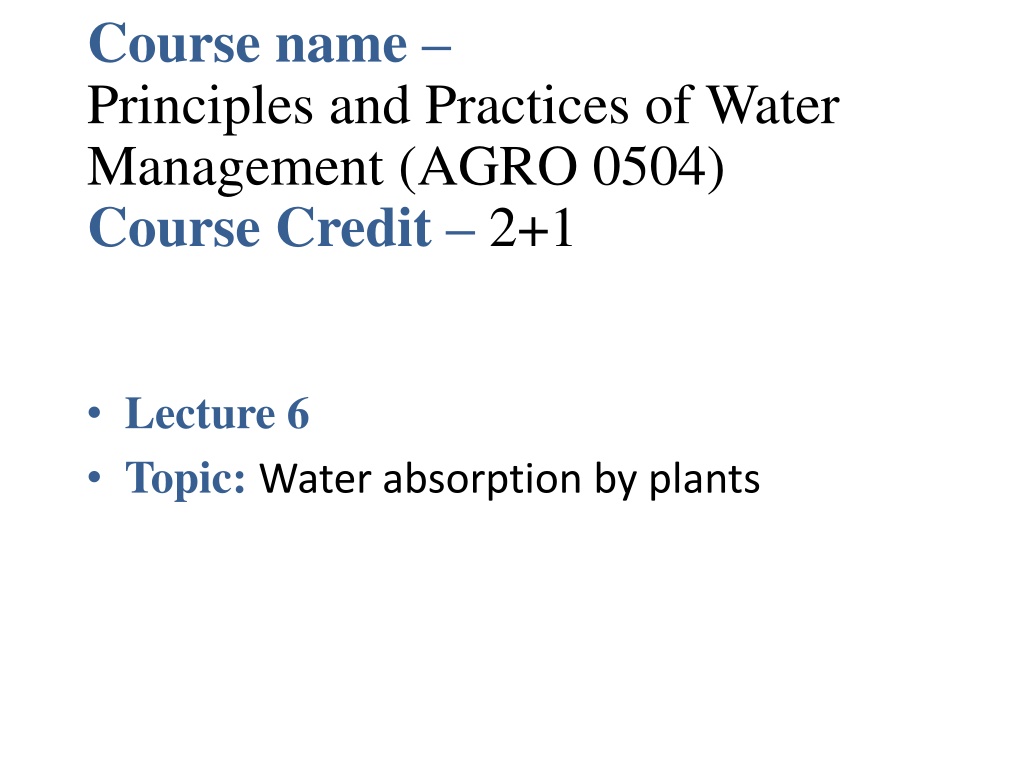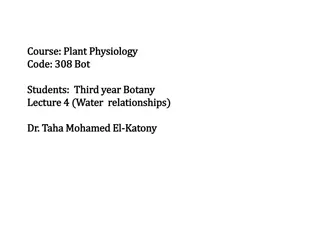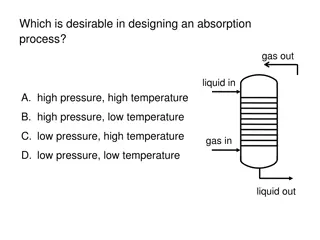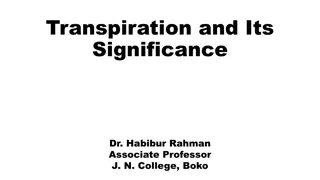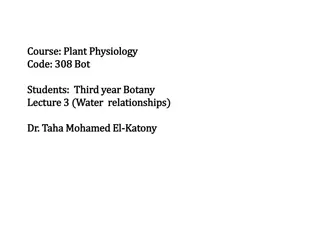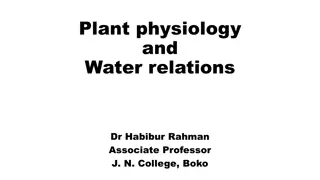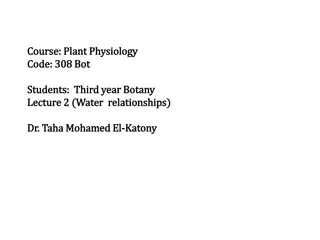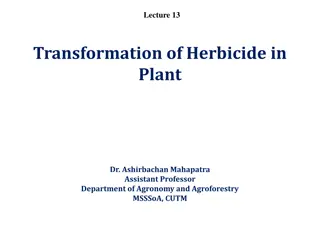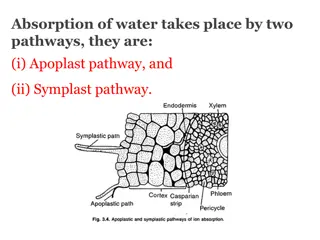Understanding Water Absorption in Plants: Mechanisms and Implications
Exploring the intricate process of water absorption in plants, this course delves into the active and passive methods used by roots to uptake water from soil, the role of osmosis in osmotic active absorption, the influence of transpiration on passive absorption, and the significance of root hairs in facilitating water uptake. By understanding these mechanisms, one can appreciate how water availability impacts plant physiology and overall ecosystem health.
Download Presentation

Please find below an Image/Link to download the presentation.
The content on the website is provided AS IS for your information and personal use only. It may not be sold, licensed, or shared on other websites without obtaining consent from the author. Download presentation by click this link. If you encounter any issues during the download, it is possible that the publisher has removed the file from their server.
E N D
Presentation Transcript
Course name Principles and Practices of Water Management (AGRO 0504) Course Credit 2+1 Lecture 6 Topic: Water absorption by plants
Water absorptions by plants; Transpiration; Soil- Plant-Water relationships; Plant response to water stress, Adaptation of plants against moisture stress condition; Water availability and it s relationship with nutrient availability and loses.
Water absorption by roots The water supply is an important factor, which directly or indirectly influences rate of photosynthesis. Plants uptake capillary water from the soil to the root xylem through the root hairs. Plants typically absorb water by (i) Active and (ii) Passive methods Active Absorption: Here water absorption requires the expenditure of metabolic energy by the root cells to perform the metabolic activity like respiration. Active absorption in plant occurs in two ways: osmotic and non-osmotic absorption of water.
Osmotic active absorption: Here water absorption occurs through osmosis where the water moves into the root xylem across the concentration gradient of the root cell. The osmotic movement is due to the high concentration of solute in the cell sap and low concentration of the surrounding soil. Non-osmotic active absorption: Here, the water absorption occurs where the water enters the cell from the soil against the concentration gradient of the cell. This requires the expenditure of metabolic energy through the respiration process. Hence, as the rate of respiration increases, the rate of water absorption will also increase. Auxin is a growth regulatory hormone, which increases the rate of respiration in plants that, in turn, also increase the rate of water absorption
Passive Absorption: Passive absorption is the type where the water absorption is through the transpiration pull. This creates tension or force that helps in the movement of water upwards into the xylem sap. Higher is the transpiration rate, and higher is the absorption of water. Role of Root Hairs in Water absorption: A root contains some tubular, hair-like and unicellular structures called Root hairs. Root hair only participates in water absorption activity. Root hair zone is the water- permeable region. Root hairs are the outgrowths, which arise from the epidermal layer called the piliferous layer.
Mechanism of Water Absorption in Plants i. In the first step, the root hairs of the plant will absorb the water from the surrounding soil through the process of osmosis. The soil has highwater concentration than the cell sap. Therefore, the water will move from a high concentration to the low concentration following osmosis through the cytoplasmic membrane of the root hairs. After entering into the root hair, the water will cross the epidermis or piliferous layer of the root system. iii. Then, the water will move to the root cortex. iv. There after water will travel through the endodermis that consists of suberic and passive cells. v. The further movement is facilitated by the passive cells. ii.
Rate of water uptake governed by a) Rooting density in the root zone profile b) Difference between average soil water suction and root suction c) Hydraulic Conductivity of the soil d) Thermal status of the soil
If the initial soil water suction is uniform throughout the rooting zone but the active roots are not distributed properly, then the rate of uptake should be highest where the active root density is maximum. However more rapid uptake will result in more faster depletion in soil water. As a result uptake pattern drastically decline in that zone.
The increase in average t with time at different depths This fig shows non-uniformity of water uptake from different soil depths under field condition
With a non uniform root system among different layers a soil water suction gradient may generate between two adjacent layer and that may induce water movement from one layer to another. In general the magnitude of this interlayer movement is smaller in comparison to difference in root water uptake rate in respective layers. But in some cases it may be notable one. The entire root zone profile can be divided in to upper and lower layers.
In upper layer root density is high and almost uniform where the water depletion rate will be almost uniform. In lower layer roots are sparse and the rate of depletion is slow as long as water content in upper layer is fairly high. The water depletion in lower layer will be due to (i) uptake by the roots; (ii) Direct upward flux from relatively moist lower layer to rapidly depleted upper layer.
Relation of actual transpiration rate to soil water content under different meteorological conditions
Relation of relative transpiration rate to average soil water suction under different atmospheric evaporative demand
Water uptake by Plants. Three components Soil-Plant-Atmosphere together constitutes a physically integrated, dynamic system in which various interdependently like links of a chain. flow process occur This unified system has been called the Soil-Plant- Atmosphere Continuum. (Phillips, 1966). Under SPAC- water moves from higher total water potential to regions of lower total water potential.
Flow of water in SPAC Can be expressed as: Where q is the volume flux density of water or briefly the water flux (e.g. in m/ day) and the subscripts (e.g. R1, R2) represent different pathways in the system, with 1 representing the soil to root pathway, 2 the root to xylem pathway, 3 the xylem to leaves pathway and 4 the leaves to the atmosphere pathway. Based on this equation, one can assume that there is a liquid continuity between water in the soil and the water evaporating from the stomata of the leaf. Throughout the SPAC, the sole driving force for water movement is the hydraulic gradient
The distribution of t in the Soil Plant Atmosphere Continuum under different conditions of soil moisture and atmospheric ET demand
